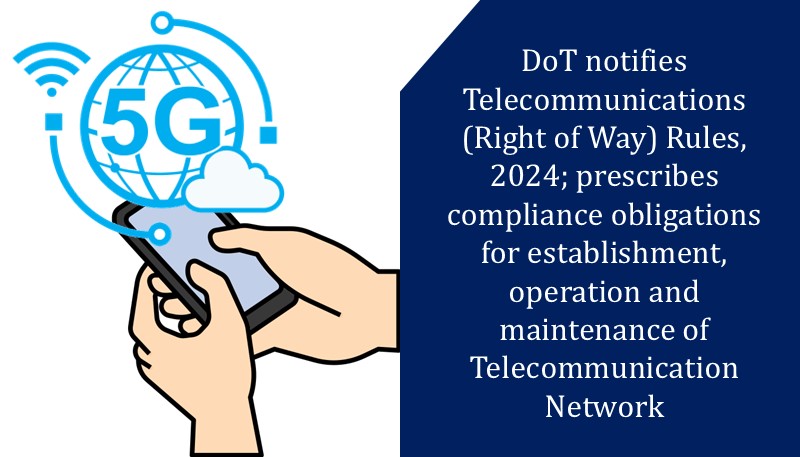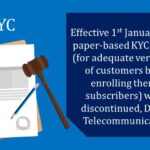The Department of Telecommunications (“DoT”), pursuant to the provisions of the Telecommunications Act, 2023 and in supersession of the Indian Telegraph Right of Way Rules, 2016 and the Indian Telegraph (Infrastructure Safety) Rules, 2022 has notified the Telecommunications (Right of Way) Rules, 2024 (“Rules”). These Rules, slated to gain effect on 1st January, 2025, establish a comprehensive framework for obtaining permissions for the right of way concerning telecommunication networks, ensuring streamlined procedures across both public and private properties.
Key Highlights:
The Rules provide specific definitions that are crucial for a precise understanding of the regulatory scope. Some key terms are as follows:
- “mobile tower” means any above-ground contrivance, including that which may be dismantled and reassembled at another location, used for carrying, suspending or supporting a telecommunication network, but does not include a pole;
- “telecommunication line” means a wire or wires or optical fibre used for telecommunication with any casing, coating, tube or pipe enclosing the same, and any appliances and apparatuses connected therewith for the purpose of fixing or insulating the same;
- “underground telecommunication network” means parts of a telecommunication network or telecommunication equipment established under the ground and includes ducts, manholes, marker stones, hand holes, submarine cables, telecommunication line, appliances and apparatuses for the purposes of establishment or maintenance of the telecommunication network;
- “overground telecommunication network” means parts of a telecommunication network or telecommunication equipment established over the ground and includes telecommunication infrastructure that is portable, posts, pole, mobile tower, telecommunication line or other above[1]ground contrivances, appliances and apparatuses for the purpose of establishment or maintenance of the telecommunication network
Key obligations:
- Permission for establishment: The Rules mandate a *facility provider to obtain prior consent by making an application accompanied by prescribed documents and fees before initiating the establishment, operation or maintenance of an underground or overground telecommunication network on public property;
- For non-public properties, a facility provider is required to enter into an agreement with the person who has ownership, control, or management over such property;
- Adherence to Grant Terms: Upon being granted right of way, the facility provider is required to comply with the following:
(a) payment of fees: payment of all specified amounts and adherence to the terms and conditions of the grant of permission from the relevant public entity;
(b) public safety and structured integrity: implementation of measures to mitigate public inconvenience and ensure public safety, including measures to ensure the structural safety of overground telecommunication network; and;
(c) maintenance of digital records: maintenance of up-to-date digital information relating to all underground telecommunication network established, including as-built information updated at a frequency as specified by the Central Government, through positional intelligence and other appropriate technology, which may be shared and updated on demand, through the portal, with the designated officer, as may be notified by the Central Government.
- Public entity oversight: Further, the Rules grant **public entities powers with respect to oversee ongoing work by a facility provider, the manner of permitting right of way by Central Government in public interest, establishment of a temporary overground telecommunication network, etc.
A copy of the Notification is attached herewith for your ease of reference.
Source: Department of Telecommunications
—————————————————————-
*Clause (a) of section 10 of the Telecommunications Act 2023
(a) “facility provider” means the Central Government or any authorised entity, including any contractor or sub-contractor or agent working for the Central Government or authorised entity, and shall include their successor or assignee;
*Clause (b) of section 10 of the Telecommunications Act 2023
(b) “public entity” means,—
(i) the Central Government;
(ii) the State Government;
(iii) local authority;
(iv) any authority, body, company or institution incorporated or established by the Central Government or the State Government, or under any statute; or
(v) any non-government entity vested with the ownership, control or management of any public facility or class of public facilities, as may be notified by the Central Government;





